
|
Ezio, my friend! How may I be of service? This article is in desperate need of a revamp. Please improve it in any way necessary in order for it to achieve a higher standard of quality in accordance with our Manual of Style. |
- "The people never have the power. Only the illusion of it. And here’s the real secret: they don’t want it. The responsibility is too great to bear. It’s why they’re so quick to fall in line as soon as someone takes charge. They WANT to be told what to do. They YEARN for it. Little wonder, that, since all mankind was BUILT to SERVE."
- ―Haytham Kenway, 1781.[src]
The Templar Order, also known as the Order of the Knights Templar, the Poor Fellow-Soldiers of Christ and of the Temple of Solomon and the Order of Solomon's Temple is a monastic military order-turned-corporate giant, which was formed during the prehistoric era. The Templars seek to create a perfect world, although their interpretation thereof directly contrasts with the ideals of their sworn enemies, the Assassin Brotherhood.
Whereas the Assassins assert that utopia can someday be achieved through a gradual process of learning tolerance and mutual understanding, Templars classically insist that human nature is too prone to corruption for this to be a possibility. Key to their dream is the imposition of a New World Order, and they envision that true peace can only come when all of humanity is shepherded by an enlightened society of people—in their eyes, them. Because of this conflict in ideology, the Templars became involved in a covert war against the Assassins, spanning millennia and continuing into the modern era. The Templars have also become enemies with the Instruments of the First Will, a cult who have sworn heir lives to restore the Isu's rule over humanity.
Organization
Originally, the title of Grand Master officially denoted the head of the Templar Order. Indeed, during the Middle Ages when the order's existence was public knowledge, the Grand Master was projected as their sole supreme commander. However, as the organization spread across the globe, establishing branches in virtually every country, the title of Grand Master came to designate only the leader of regional factions called Rites.[9]
Beneath the Grand Master of each Rite are nine ranks, with immediate subordinates being the high-ranking Master Templars. In order following the Masters are the Seneschals, Advisors, Commanders, Preceptors, Knights, Warriors, Clerics, and finally, the Disciples.[10] These ranks parallel a similar system of hierarchy among their mortal adversaries, the Assassins.[9]
Inner Sanctum
To maintain cohesion of the Rites as components of a centralized entity, the Inner Sanctum was formed. Consisting of an elite group of nine Templars, the Inner Sanctum harbors direct knowledge of all of the order's plans and is the nucleus from which orders are relayed to the other Rites. Their number, nine, reflects a convention that dates back to at least the Third Crusade, when nine leading Templars coordinated closely to seek after the Apple of Eden in Solomon's Temple.[2] In modern times, since the foundation of Abstergo Industries as a public front for the order, the Inner Sanctum simultaneously serves as Abstergo's Board of Directors.[5][9]
Outer Temple
The Inner Sanctum, in turn, is classified as one of two parts of the order, the other being the Outer Temple. Whereas the Inner Sanctum is privy to all the affairs of the order, being responsible for them, the Outer Temple comprises all other Templars, all of whom are kept in the dark of the full details and extent of the order's operations.[9]
Guardians and General of the Cross
Although the Inner Sanctum acts as the executive arm of the Templar Order, even they are not its paramount leaders, for they are ultimately subservient to the Guardians and the General of the Cross, the latter of whom is the true head of the Templar Order. Every major decision of the Inner Sanctum must be passed to the Guardians for review, who in turn relay them to the General of the Cross for the ultimate grant of approval. Accordingly, the General possesses the sole power to veto any significant action or plan the Inner Sanctum seeks to undertake.[9]
Under normal circumstances, even the Inner Sanctum does not know the identity of the General of the Cross, a secret so strictly guarded that only the Guardians are permitted knowledge of it. As a result, the Guardians are the bridge between the Inner Sanctum and the General of the Cross, the medium through which communication between the two exists. There are three Guardians, and as witnessed in the case of the Guardian Alan Rikkin who also served as Chief Executive Officer of Abstergo Industries and chairman of the Inner Sanctum, a Guardian may hold another office at the same time.[9]
Council of Elders
Apart from the Inner Sanctum and the Guardians, there exists a Council of Elders which wielded some authority over even the Guardian Alan Rikkin. Among the Council's functions is the power to dissolve Abstergo Foundation based on whether they believe the subsidiary is a worthy investment or a waste of resources.[11]
History
Prehistory
According to legend, the organization that would later be known as the Templar Order was founded by Cain, a son of Eve and Adam, who murdered his brother Abel for an Apple of Eden.[9]; the Templars' crest is rumored to have been the mark of Cain.[9] Despite their aims being aligned, a conflict in ideology quickly led to the Templars becoming an archenemy of the Assassins, who, as opposed to the Templars, sought to allow the people to retain free will.[3]
Ancient world
Aiding the Achaemenid Empire
During the Achaemenid Dynasty of Iran, the Templars aided King Darius I when he overthrew the usurper of the Empire and became the king of Persia.[8]
The Templars continued to aid his son, Xerxes I, during his invasions of Greece.[8]
Assisting Alexander the Great
The Templars' influence reached out to Macedonia, where they succeeded in allying themselves with Alexander the Great. As a symbol of their alliance, the Templars entrusted Alexander with one of the Staves of Eden, which helped Alexander to create one of the largest empires in history and become one of the most successful military commanders.[8] However, Assassin interference resulted in Alexander's poisoning in 323 BCE, by the Babylonian Assassin Iltani.[3]
Qin Dynasty
The Templars also became strong allies of Qin Shi Huang, the first emperor of China and also the founder of several of China's most famous landmarks.[8] Qin Shi Huang was killed by the Chinese Assassin Wei Yu in 210 BCE.[3]
Ancient Rome
During the later days of the Roman Republic, the Templars heavily influenced its ruling body, the Senate. Their intervention in Roman politics was continuously thwarted by the Assassins, however. A notable example of this was the plot against the Templar-backed general Gaius Julius Caesar, who was appointed dictator for life. Forty Assassins, most notably Marcus Junius Brutus and Gaius Cassius Longinus, planned to assassinate Caesar, a plan which they successfully executed on 15 March 44 BCE.[12] In 30 BCE, the Templar-allied Queen[8] of Egypt and former Caesar's lover, Cleopatra, was killed by the Assassin Amunet by use of a venomous snake.[3]
Additionally, the Templar-influenced Emperor Caligula was stabbed with a dagger by the Assassin Leonius on 24 January 41 CE.[3]
Crucifixion of Jesus
During the 1st century, they found out that one of the Pieces of Eden, the Shroud, was in the hands of Jesus Christ. Wanting the Piece for their own purposes, the Templars crucified Jesus in order to gain it.[3]
Retrieving of the Ankh
By 259, the Templars still had positions within the Roman Empire. However, during the same year, the Assassin Aquilus, guided by his father Lucius, had begun taking down a number of Templars, until he got to his third target: the Roman general Gracchus. Being given entrance to Gracchus' military tent, he confronted Aquilus with the information he had gathered on the Assassin's activities. Trying to prevent Aquilus from killing him, Gracchus stabbed Aquilus in the chest;[13] however, the wound was not fatal, and the Romans were quickly attacked by Alamanni.[1]
Around this time, the Roman senator Caïus Fulvus Vultur - a secret Templar - traveled to Lugdunum to meet with his old contact Lucius; at the same time, Aquilus was traveling home to Lugdunum, carrying with him the Ankh, an ancient artifact capable of reviving the dead which Aquilus retrieved from his Alaman cousin Accipiter. Lucius and Aquilus, both unaware of Vultur's affiliations, had Vultur stay in their home temporarily. The same night, Aquilus interrogated the Templar priest Faustin, whom Lucius suspected on having informed Gracchus. Simultaneously, Vultur betrayed Lucius, killing him and taking possession of the Ankh. Faustin revealed Vultur's ties to Aquilus, who rushed back home, only to find his father dead and the Ankh gone.[1]
Middle Ages
- "Non nobis Domine, non nobis, sed Nomini Tuo da Gloriam"
"(Not to us God, not to us, but to Your Name Give Glory)" - ―The motto of the monastic Templar Order[src]
Formation as a Knightly Order
As Christian European lords tried to retake the Holy Land from its Muslim rulers during the Crusades, Bernard de Clairvaux decided the Templars needed the Church as an ally. He sent nine men to Solomon's Temple: upon their return nine years later, Grand Master Hugues de Payens and Bernard created the Latin Rule, and reorganized the Templars into a public Order of knights, whose apparent sole purpose was to protect pilgrims to the Holy Land. In the 1129 Council of Troyes, the Order was officially recognized by the church.[8]
As the Assassins had also been made a public organization and as they were primarily based in the Levant at the time, the two factions often clashed.
Quest for the Chalice
In 1190, the Templars had come into possession of a powerful artifact simply known as the Chalice. Hiding it away in the Temple of the Sand, and needing three keys to unlock it. The Assassin Altaïr Ibn-La'Ahad managed to obtain the keys and break into the Temple in search of the Chalice. Taking the Chalice back to Tyre, the Templars prepared to set sail with it, however they were again confronted by the Assassin, who managed to kill Lord Basilisk. The Templars, however, succeeded in taking the Chalice.[14]
Third Crusade
By 1191, the Templars had come under the leadership of Robert de Sable. The Templars joined in the Third Crusade that was waging in the Holy Land, and De Sable started secretly recruiting men on both sides of the war. Among these were Garnier de Naplouse, William of Montferrat and Sibrand on the Crusader side, and Tamir, Talal, Abu'l Nuqoud, Majd Addin and Jubair al Hakim on the Saracen side. Unknown to the Assassins however, was that Al Mualim, the Mentor himself had joined with the Templar cause, though only as a means to obtain the Apple for himself. These ten men found an Apple of Eden together in Solomon's Temple, and made a few discoveries with it.[2]
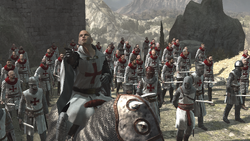
Robert de Sable leading the Templars to Masyaf
When Robert de Sable and a few of his men went to retrieve it from the temple, though, their progress was delayed by a small group of Assassins consisting of Altaïr Ibn-La'Ahad and the brothers Malik and Kadar Al-Sayf, who were sent by Al Mualim to retrieve the treasure. Despite Altaïr being routed, Kadar's death, and Malik losing his arm, the artifact was brought into Assassin possession. This event prompted Robert to lead his men to an attack on the Assassins' fortress of Masyaf, but as soon as they arrived at the fortress gates, they were routed by a wave of falling tree logs.[2]
Al Mualim sent Altaïr Ibn-La'Ahad on a quest to take down nine Templars . One by one, the Templars spread throughout the cities of Damascus, Acre and Jerusalem, fell to Altaïr's blade, until he was assigned to take down Robert de Sable. De Sable had foreseen when his time would come, and assigned Maria Thorpe to impersonate him at Majd Addin's funeral, while Robert himself would ride for Arsuf in an attempt to have the Crusaders and Saracens unite in the face of the “Assassins threat”. The Assassin fell for the trap, but quickly found out about Robert's true location. Robert and Altaïr engaged in a battle at Arsuf before Robert was successful in his plan, and Robert was defeated. Before dying, he revealed to Altaïr that the last Templar was his own master, and the Assassin rode off to his final target. After Altaïr killed Al Mualim, the Apple was ultimately lost to the Assassins.[2]
Relocating to Cyprus
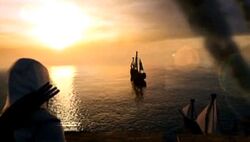
The Templars sailing to Cyprus
Control of the Order fell to De Sable's successor, Armand Bouchart. Not too soon afterwards, Bouchart bought the island of Cyprus from King Richard I, which was formerly ruled by the secret Templar Isaac Comnenus. Planning to retrieve all the artifacts that were hidden in Templar Archive underneath Limassol, the Templars set sail from Acre to Cyprus in the fall of 1191.[15]
The Templars quickly expanded their reach, starting with building strongholds in Limassol but rapidly taking control of Kyrenia as well. As the Templars used brute force to stay in control, the people formed a Resistance force that aimed to route the Templars from Cyprus. Additionally, the Templars were followed by Altaïr Ibn-La'Ahad, who had taken Maria Thorpe as a captive. Due to Altaïr's efforts, all of Bouchart's generals in Limassol and Kyrenia were assassinated, and the Templars began to lose grip of Cyprus.[15]
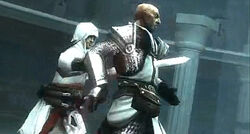
Altaïr killing Bouchart
Despite the loss of many men, the Templars were successful in their objective, because while Altaïr was busy with removing Templar control in Kyrenia, the Templars had shipped out all of the artifacts in the Templar Archive underneath Limassol. After all the artifacts were shipped out, Bouchart found himself confronted by Altaïr in the Archive. The two faced off in a duel, but Bouchart too fell to Altaïr's blade.[15]
Returning underground
By 1307, the French King Philip IV was manipulated by the French Assassin Mentor Guillaume de Nogaret into accusing the Templars of heresy, forcing Pope Clement V to disband them.[6] The Grand Master Jacques de Molay allowed himself to be burned at the stake to fool his enemies into believing the Templars were destroyed. However, Jacques passed his knowledge of the Ancients to nine of his subordinates, whom he sent into the world to continue his work, so the Templars would fade from public awareness and operate underground.[8]

De Molay burned at the stake
In 1321, the Templars killed the Italian Assassin Dante Alighieri, making their existence known to the Assassins. Three years later, they also killed the Assassins Marco Polo and the father of Domenico Auditore.[3]
Hundred Years' War
In 1337, England's House of Plantagenet, which held a strong claim on the French crown, attacked the Kingdom of France, ruled by the House of Valois. Around 1428, a young French women named Jeanne d'Arc, who had somehow obtained one of the Swords of Eden, joined the French forces and lead them French to a series of victories. However, this caught the attention of the Templars, who had set their sights on the Piece of Eden she had in her possession. In 1430, Jeanne was captured and interrogated by the English, before being executed by burning by the Templars, who subsequently gained possession of the Sword.[3]
Renaissance
In the second half of the 15th century, the Brotherhood had regained a stronger position of strength on the world stage, spreading deep into the Church and nobility of Italy, which served as the primary headquarters of Templars and Assassins alike during this era. Under the command of Rodrigo Borgia, the Templars sought to unify Italy under their command, and regain the Apple of Eden which they knew to be buried in Cyprus.[2]
Sforza assassination
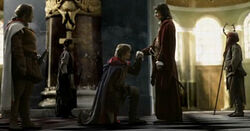
Lampugnani kissing Sforza's hand
Under Rodrigo, the Templars sought to remove the Sforza family from power in Milan, thus destabilizing the city's relations with Florence. Their plan was to assassinate the Duke, Galeazzo Maria Sforza, on the Feast of Santo Stefano. Rodrigo, having made plans in Florence, left the city with a couple of henchmen, but was followed by Giovanni Auditore da Firenze, an Assassin. Rodrigo, frightened, left his henchmen to fight Giovanni while he made his escape. Giovanni managed to kill the henchmen, and take one captive. Giovanni brought this man to the Medici, where he was tortured by Lorenzo de' Medici and Uberto Alberti, who was secretly a Templar.[4]
Having gathered enough information on their plans from Rodrigo's henchman, Giovanni hurried to Milan to prevent the Duke's assassination. However, the Templars Giovanni Andrea Lampugnani, Carlo Visconti and Gerolamo Olgiati killed the Duke when the church bell rang for the twelfth time. Visconti and Olgiati managed to escape, while Lampugnani was killed by a Sforza guard.[4]
Auditore execution
Having been successful in their plan for Milan, the Templars switched their attention to the city of Florence. However, Florence's de facto ruler, Lorenzo de' Medici, was an ally of the Assassin Giovanni Auditore, and his family was a strong enemy of the Pazzi family; the Templars' main stronghold in Florence. In order to avoid further interventions from the Assassins, Giovanni Auditore and his two sons Federico and Petruccio were imprisoned in the Palazzo della Signoria, and they would be trialed by their former ally Uberto Alberti, who was corrupted by the Borgia.[3]
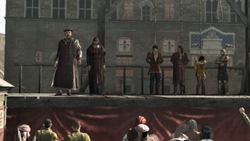
Uberto Alberti and Rodrigo Borgia watching over the Auditore execution
However, the Pazzi guards were unable to capture Giovanni's remaining son; Ezio. Nonetheless, Giovanni, Federico and Petruccio were hanged in front of the Palazzo della Signoria. Ezio, who had attended the execution, realized that his family had been betrayed by Alberti, and after escaping, began making preparations for his revenge. Not too soon afterwards, Ezio, using his father's equipment, killed Alberti during an exhibition of Verrocchio's latest work.[3]
However, the Borgia, believing their problems with the Assassins were solved, continued with their plans to take down the Medici.[3]
Pazzi Conspiracy
Over the next two years, the Templars, majorly the Pazzi family, continued their schemes for control over Florence. In 1478, Rodrigo met with Jacopo, Francesco and Vieri de' Pazzi in San Gimignano, discussing everyone's tasks in the conspiracy. However, Vieri was killed right after the meeting ended by Ezio, who had attacked the town alongside his uncle Mario and his mercenaries.[3]
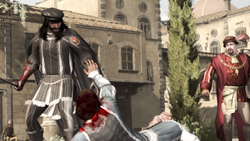
Francesco attacking Giuliano, with Bernardo in the back
Nonetheless, the Templars continued their plans, again arranging a meeting underneath Santa Maria Novella not too long after the former meeting. Rodrigo, who had received Pope Sixtus IV's blessing on the conspiracy on the condition that nobody was killed, was again present, and made the final preparations. The following Sunday, the Pazzi attacked the Medici when they arrived at the Basilica di Santa Maria del Fiore for High Mass; the event that would be known as the Pazzi Conspiracy. Francesco successfully killed Giuliano de' Medici, stabbing him in the chest nineteen times, but the Pazzi Conspirators were only able to wound Lorenzo de' Medici, who was joined by Ezio Auditore in fighting off the Medici. With Ezio's help, Lorenzo managed to escape, but the Pazzi did not cease to cause trouble in the city. On Lorenzo's request, Ezio hunted Francesco de' Pazzi down and killed him.[3]
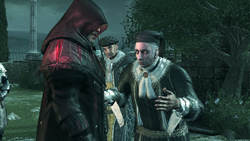
Jacopo trying to reason with Rodrigo
With the Templars routed from Florence, Jacopo and the other conspirators fled to San Gimignano in Tuscany, where they had once again arranged to meet with Rodrigo in 1480. However, all four remaining Pazzi Conspirators - Bernardo Baroncelli, Antonio Maffei, Stefano da Bagnone and Francesco Salviati - all fell to Ezio's blade over the course of two years. Jacopo went to the meeting alone, where his failure and words angered Rodrigo; in the process, Jacopo was stabbed in the chest, nearly killing him. Sensing Ezio's presence at the meeting, Rodrigo sent his guards after the Assassin; nonetheless, Ezio was once again able to fend the guards off and put Jacopo out of his misery. With their plans for Florence thwarted by the lone Assassin, the Templars turned their attention to Venice.[3]
Taking over Venice
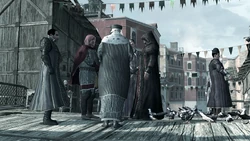
The Barbarigos meeting with Rodrigo Borgia
By 1480 in Venice, Emilio Barbarigo was attempting to unite all the merchants in Venice's commercial district under his banner. Despite failed attempts from the city's Thieves Guild, Emilio was assassinated in 1486 by Ezio Auditore. A meeting between Carlo Grimaldi, Silvio Barbarigo, Marco Barbarigo, Dante Moro and Rodrigo Borgia took place soon afterwards, discussing their plans for Venice. They decided that they would kill the Doge, Giovanni Mocenigo, that same night and that Marco Barbarigo would take his place. In fact, the plan to take the Doge's seat was a plan to distract the Assassin from the Templars' real objective: retrieving the Apple of Eden from Cyprus.[3]
Ezio Auditore, who had eavesdropped on the meeting, quickly devised a strategy to prevent the killing of Mocenigo and used Leonardo da Vinci's flying machine to infiltrate the Doge's residence, the Palazzo Ducale. However, Ezio was too late to prevent the Doge from being poisoned, but he managed to kill Carlo Grimaldi, who was responsible for the Doge's death.[3]
Marco had taken the position of Doge, never to come out to prevent the Assassin from having an opportunity to kill him. However, during Carnevale, Marco was obliged to show himself to the people at his personal party. Ezio had managed to obtain entry to the party, and as soon as Marco showed himself, the Assassin struck.[3]
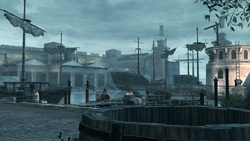
The Templar boats setting sail from the Arsenal
Due to the Assassin's efforts, the Venetian Templars had to rely on Silvio Barbarigo and Dante Moro. They had hired a group of mercenaries to strengthen their forces, and positioned themselves in the Arsenal of Venice, fighting with Venice's Mercenaries Guild led by Bartolomeo d'Alviano. Ezio Auditore joined forces with Bartolomeo, and together they managed to draw Silvio and Dante away from their troops. Without any protection, the two attempted to flee to their boat inside the Arsenal to sail to Cyprus, but they were killed by Ezio before they could set sail. Other boats had already managed to set sail, though, and were on their way to Cyprus.[3]
Quest for the Apple
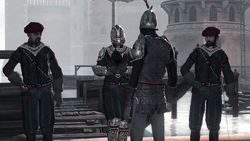
The Apple being given to the courier
Despite the Templars facing "complications" on Cyprus, the Templar boat returned to Venice in 1488. A Templar courier was assigned to bring the Apple to a Templar guard post, from where the Apple would be escorted to Rodrigo Borgia. However, Ezio killed the guard assigned to carry the Apple, and put on his uniform; impersonating him. After the escort had reached Rodrigo, its members were killed by Ezio and the latter faced off in a fight with Rodrigo. Ezio was later joined by other members of the Assassin Order, and Rodrigo made his escape, leaving the Apple behind.[3]
With the Apple in the hands of the Assassins, the Templars approached the Orsi brothers – Ludovico and Checco – to obtain a map detailing the location of the Codex pages from the wife of the Templar Girolamo Riario – Caterina Sforza. Invading Forlì, the Orsi brothers demanded the map, and the Apple in exchange for the lives of Sforza's children. The brothers were rebuked, and assaulted the Rocca di Ravaldino. Together with the city guards, the Assassins Ezio Auditore and Niccolò Machiavelli held off the assault, although a second succeeded in claiming the Apple briefly when Ezio Auditore left to kill Ludovico. After Ezio had returned successfully, he chased after Checco and assassinated the latter, taking the Apple with him.[16]
Control over the Papacy
Despite the loss of the Apple, Rodrigo was ultimately unfazed. In 1491, he became a candidate in the Papal conclave and fooled the Spanish Inquisitor General Tomás de Torquemada into following his orders. Much of these orders involved annihilating the Assassins Guild in Barcelona, Spain, with Rodrigo claiming they were heretics. Rodrigo also made attempts to thwart Christopher Columbus' journey to the New World, and planning to make the Templars journey there. However, all of these plans were thwarted again by Ezio Auditore, who had sailed to Spain.[17]
On 11 August 1492, Rodrigo had become Pope Alexander VI after having bribed most of the cardinals.[18] Being the head of the Christian church, the Templars became the most powerful force in Europe and based their headquarters in Rome.[12] As the Pope, Rodrigo had access to the Papal Staff, which was in reality one of the Staves of Eden.[3]
In the late 1490s, Rodrigo learned that the Apple had come into the possession of the monk Girolamo Savonarola, who had just become the ruler of Florence. Aiming to get the Apple back in their possession, the Borgia sent continuous waves of soldiers to Florence. However, the bodies kept being sent back,[19] and the Borgia were disappointed when Savonarola was executed without them having the Apple in their possession.[20]
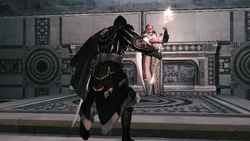
Ezio confronting Rodrigo in the Vatican
In 1499, the leading Assassins in Italy traveled to Rome to distract the Borgia guards, while Ezio traveled along the Passetto di Borgo to St. Peter's Cathedral. Once inside, the Assassin lunged at Rodrigo Borgia while he was proclaiming the Nicene Creed in Latin to the congregation. Rodrigo shoved the Assassin away, then used the Staff to subdue his entire congregation. A fight ensued with Rodrigo using the Staff and Ezio using the Apple. The power of the Staff was able to overpower Ezio, and after Rodrigo stabbed Ezio in the abdomen, he entered the Vault underneath the Sistine Chapel. Rodrigo wasn't able to enter the Vault, though, as only the "Prophet" could do it. Rodrigo was soon faced by Ezio again, and after one final fight in hand-to-hand combat, Ezio informed Rodrigo that he was not the Prophet and had never been. Broken by this revelation and accepting defeat, Rodrigo told Ezio to kill him and put an end to it, but unlike Ezio's other targets, Rodrigo was not killed as Ezio could not find a reason to do so, stating that killing him wouldn't bring his family back. As Ezio entered the Vault, Rodrigo fled back to safety.[3]

Cesare Borgia in Monteriggioni
Five days afterwards, Rodrigo's son Cesare, who served as the Captain General of the Papal Army, had slowly begun to take control over the Templar Order and laid siege to the Assassins' and Auditore's headquarters of Monteriggioni. In the process, the Templars captured Caterina Sforza, executed Mario Auditore, shot Ezio Auditore and obtained the Apple of Eden. After Monteriggioni lay in ruins, the Borgia returned to Rome victorious.[12]
As control over the Templars slowly shifted to Cesare, he became the new Grand Master and strived to take over all of Italy, and later Europe. As the Templars were ruling the church, individuals such as King Louis XII of France, King Ferdinand II of Aragon and King Manuel I of Portugal all answered to the Borgia. Meanwhile, Cesare planned to strengthen his army with war machines created by Leonardo da Vinci, who had been forced into serving the Borgia. With his army, Cesare quickly conquered various states in Italy.[12]
However, Ezio Auditore had moved to Rome and started rebuilding the Assassin Brotherhood there. In Cesare's absence, Ezio destroyed the war machines and the Assassins killed most of Cesare's high-ranking generals, including his personal banker Juan Borgia and the French general Octavian de Valois. Control over Rome became lost to the Templars, and their plans couldn't be executed. Returning home from war, Cesare found all his support gone and his funds cut off.[12]
Routing from Italy
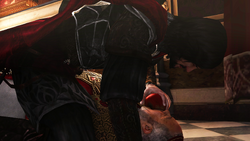
Cesare Borgia killing his father
On 18 August 1503, Rodrigo, who had begun to see Cesare as a threat, met with his son in the papal apartments of the Castel Sant'Angelo. There, he placed a platter with poisoned apples on the table, and as planned Cesare took a bite from one of them. However, Cesare's sister Lucrezia had found out about Rodrigo's intentions and entered the room to warn her brother. Furious, Cesare shoved the remaining apple down Rodrigo's throat, asking him where the Apple was simultaneously. However, Rodrigo died and Cesare obtained the Apple's location after threatening his sister. Ezio Auditore entered the room after Cesare left, and also got the Apple's location from Lucrezia. Both Cesare and Ezio raced to the Apple, though the latter got to it faster. With the Apple, Ezio exterminated most of Cesare's remaining followers and Cesare himself was arrested on orders of Pope Julius II.[12]
Cesare, who had become the sole ruler of the Templars, was able to escape his imprisonment in the Castel Sant'Angelo. He tried to escape by boat, but was captured by Ezio once again. The Pope had Cesare transferred to Castillo de la Mota, Aragon in Spain in 1504; a location that only the Pope was aware of.[21]
In 1506, Cesare was freed from La Mota by Micheletto Corella, and together they rode to Valencia. There, Cesare started to raise an army, operating from the Lone Wolf Inn. Ezio, who had used the Apple to track Cesare, destroyed Cesare's encampment and twelve ships together with Niccolò Machiavelli. Cesare blamed Micheletto for the attack, and the latter attempted to strangle Cesare. Cesare gained the upper hand during the struggle, though, and shot Micheletto. Without any men, Cesare made his escape to the Kingdom of Navarre, ruled by his brother-in-law John III.[21]
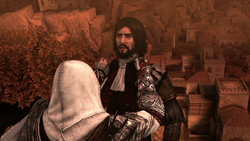
Ezio letting Cesare fall to his death
In March 1507, John III appointed Cesare to lead his forces during the Siege of Viana. During the battle, Cesare was once again faced by Ezio, who used the Apple to locate Cesare. Cesare made his escape towards the castle, but was ultimately confronted by Ezio atop the walls of Viana Castle. After being defeated, Cesare got thrown off the castle walls by Ezio. With Cesare's death, the Templars were no longer led by the Borgia and their quest to conquer Italy and the rest of Europe was at an end.[12]
Search for the Masyaf Keys
Following the earthquake in Constantinople in 1509, Templars reappeared in the city under the Byzantine banner. Due to Sultan Bayezid II's disappearance from the city following the earthquake, the Byzantine Templars could easily integrate into the city and start their plans for taking over the Ottoman Empire, while operating from their headquarters in the underground city of Derinkuyu in the region of Cappadocia.[5] Initially led by Manuel Palaiologos, the Byzantine Templars quickly caught the eye of Prince Ahmet, Bayezid's son and supposed successor. Ahmet joined the Templar Order, and his youth and charisma allowed him to slip into the position of leader while Manuel was forced to become a second-in-command.[8]
The Templars somehow recovered "The Secret Crusade", the journal of the Italian explorer and secret Assassin Niccolò Polo, from which they found out about the existence of the library of Altaïr Ibn-La'Ahad in Masyaf and the keys needed to open it. Ahmet placed Manuel Palaiologos in charge of the Masyaf expedition to find the Masyaf Keys throughout Constantinople, while Ahmet himself continued his plans to secure the Templars' power in the Empire.[5]
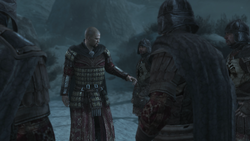
Leandros giving instructions to the Templars
By 1511, the Templars had managed to obtain one of the Masyaf Keys from underneath Topkapı Palace, and had taken full occupation of Masyaf. Without the other Keys in their possession, the Templars had resorted to digging their way into the library, with no success. In the winter of 1511, Ezio Auditore da Firenze arrived in Masyaf, also wanting to access the library. He was ambushed by Byzantine Templars led by Leandros, and was overpowered and captured. The Templars subsequently led him to Masyaf's watchtower, where he was to be hanged. At the very last moment, he fought back against Leandros, who was tying the noose around Ezio's neck. Ezio threw the noose around Leandros' neck instead, and Ezio jumped down to a scaffolding below. With no sign left of Ezio in the thick snowstorm that was brewing, Leandros instead decided to focus on other matters and was about to leave on a horse cart. Ezio gave chase, and jumped to a rope hanging on Leandros' cart, eventually procuring his own cart and chasing Leandros.[5]
Leandros crashed Ezio's cart near Atlas Village in the mountains, and made his way into the village while sending the other Templars to deal with Ezio. However, the wounded Ezio made his way through the guards and into the village's center with some difficulty, coming to the area where Leandros had taken refuge. Leandros, sending more of his men at Ezio, was ultimately confronted and killed by Ezio on top of the village's watchtower, where Ezio took "The Secret Crusade" from him.[5]
Struggle in Constantinople
In Constantinople, the Templars were still ever present, engaging in heavy combat with the Turkish Assassins, occupying numerous Assassin Dens throughout the city and searching for the secret locations in the city leading to the Masyaf Keys. The Templars discovered that two of the Masyaf Keys were located in the Yerebatan Cistern and the Forum of the Ox, but Ezio Auditore recovered the artifacts before the Templars could.[5]
Ahmet personally devised a plan to have his nephew Prince Suleiman kidnapped at a feast in the Topkapı Palace, allowing Ahmet to "rescue" him and gain the Ottoman citizens' favor over his brother Selim for the Ottoman throne. However, Yusuf Tazim and the Turkish Assassins found out about the Templars' plan and plotted to stop their plan. With the help of Ezio Auditore, the Turkish Assassins - dressed as Italian minstrels - found and killed all of the Templars hidden amongst the party goers. Ahmet, of whom no one was aware of his Templars affiliations, instead accused Tarik Barleti, the captain of the Janissaries, from being unable to stop the 'attack' of the Italian minstrels.[5]
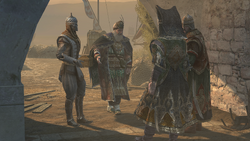
Manuel and Shahkulu making the deal with Tarik
Some time later, Manuel journeyed to Constantinople to buy guns from the Tarik and the Janissaries to arm the Templars in Cappadocia with them. Accompanied by the Turkmen renegade and Templar Shahkulu, Manuel inspected the weapons in the city's arsenal and successfully closed the deal before returning to Cappadocia. Tarik was assassinated by Ezio Auditore some time later on Suleiman's orders, after the two came to the wrong conclusion that Tarik was in league with the Templars; Tarik had instead been spying on the Templars in Cappadocia in order to thwart them. Tarik's death was quickly believed to be conducted by Ahmet, damaging his public image.[5]
Collapse of Cappadocia
Manuel and Shahkulu returned to Derinkuyu in Cappadocia, where they continued building up the Byzantine army's strength and the capture and execution of numerous Ottomans.[5]
Due to Ezio Auditore, who had trailed Manuel to Cappadocia, an Ottoman spy named Dilara was captured from Templar imprisonment. Consequently, Shahkulu gained the attention of Dilara and Ezio. Ezio jumped down and stabbed Shahkulu from on high, though Shahkulu resisted against Ezio and a fight ensued. Ultimately, Ezio killed Shahkulu and simultaneously stopped the torture and execution of the Ottoman spies in the city.[5]

Manuel and a Byzantine spotting Ezio
The Templars panicked when Ezio Auditore blew up the ammunition and armaments hidden inside the city, and Manuel Palaiologos tried to calm the city's citizens. Upon spotting Ezio, Manuel fled and sent the Templars to kill Ezio. The Templar soldiers proved no match for Ezio, and the Assassin confronted Manuel after the latter ran to a dead end on a jetty. Manuel was easily slain, and gave up his Masyaf Key to Ezio, cynical that he would survive long enough to enter the library. At that very moment, Ahmet arrived on the scene by boat, revealing his Templar affiliations and threatening to capture Ezio's love interest Sofia Sartor when Ezio did not give up the Masyaf Keys.[5]
Fall of the Byzantines
Ahmet returned to Constantinople not too long afterwards, and sent a battalion of Templars to capture Sofia from her book shop. The book shop was guarded by Yusuf Tazim and other Assassins, though the Templars emerged victorious, killing Yusuf in the process. Upon discovering Yusuf's lifeless body, Ezio rallied the Assassins against Ahmet and the Templars, who had located themselves in the arsenal. When Ezio reached Ahmet, the latter explained that his death would prevent Ezio from knowing where Sofia was, and subsequently lectured Ezio that they both wanted peace and tried to convince him of the people's reluctance to acknowledge the truth. Unsuccessful in convincing the Assassin, Ahmet instead told Ezio to meet him at the Galata Tower with the Masyaf Keys.[5]
Ahmet and a group of Templars waited for Ezio on the wall of Galata Tower, and demanded the Keys from Ezio upon his arrival, in exchange for Sofia, who was held by a Byzantine atop Galata Tower. However, Ahmet instead had Azize[22] dressed in Sofia's clothing with a bag hidden over her head held by the Byzantine soldier, while the real Sofia was being hanged on a nearby plaza. Ahmet made his leave out of the city with the Masyaf Keys, and started his journey to Masyaf to open the library.[5]
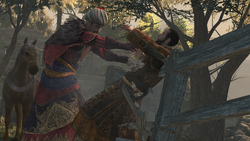
Selim killing Ahmet
Ahmet and his Templar entourage were tailed by Ezio and Sofia, who was rescued by Ezio, and a chase on horse cart ensued. The other Templar horse carts were taken out by Ezio, only to be knocked off his own cart by Ahmet. Ahmet continued making his way forward, with Sofia driving their horse cart and Ezio hanging on to the cart with a parachute deployed. After a long chase through the mountains, Ahmet obliterated Sofia's cart. Ezio landed on a nearby hill and from there jumped onto Ahmet's cart, causing the two to fall off a cliffside.
Though initially fighting during their freefall, Ezio deployed another parachute to result his safe landing, while Ahmet held on to Ezio. They both safely landed, but showed signs of heavy fatigue. At that moment, Selim arrived with his army from battle with his father, and walked up to Ahmet. Revealing that he had been assigned as the next Sultan, Selim started choking Ahmet and threw him off a cliff to ensure that there would be no conflicts for succession. With Ahmet's death, the Byzantine Templars were ultimately dissolved.[5]
Aiding Jiajing's ascendance
In 1521, Emperor Zhengde of China passed away, and lacked a proper heir. The Chinese Templars, eager to gain power, aided in the ascendance of Zhengde's nephew Jiajing. With Jiajing as the Emperor, the Assassins in China were hunted down and nearly fully eradicated. The remaining Assassins were forced to flee, with Jiajing's men in hot pursuit. The imperial soldiers even followed the Assassins to Europe, where the Assassin Shao Jun had made her way to Italy in order to seek aid from Ezio Auditore, the now-retired Mentor of the Italian Assassins. Jiajing wanted the Chinese Assassins eradicated at all costs, and the imperial guards even went as far to attack Shao Jun in Ezio's villa in Tuscany. However, Shao Jun and Ezio, in his mid 60s, were able to defeat the soldiers.[8]
Age of Reason
Templars looked at the Renaissance as a dark time for the Order: while other men progressed humanity's knowledge, 15th-century Templars led by the debauched Borgia did not care for such ideals, using the Order as a platform to gain power and influence. By the 17th century, the Templars began adjusting their philosophy. Instead of making personal bids for powers, the Templars sought to influence rather than control the leaders and intellectuals of the new age.[8]
Golden Age of Piracy
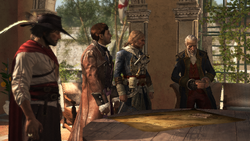
A Caribbean Rite Templar meeting
In the following centuries, the Templars expanded their enterprise to the New World, establishing their first notable Rite in the West Indies, led by Laureano de Torres y Ayala and operating largely out of Havana, Cuba. It was the mission of this branch to locate and secure the First Civilization site known as the Observatory, a complex that would further the Templar goal of influencing world governments through the application of precursor technology to spy, blackmail, and coerce politicians and other men in positions of power.[23]
Although the Templars searched for nearly fifty years, it was only in 1715 that they received their first solid lead, locating a Sage named Bartholomew Roberts and bringing him to Havana. With the Sage's knowledge, the Templars planned to finally find the Observatory; however, the Sage's subsequent escape, coupled with the discovery that one of their newest recruits, Duncan Walpole, had been impersonated by the pirate Edward Kenway, set the Order back once again.[23]
In the next years, Templar Woodes Rogers, governor of the Bahamas, attempted to dislocate pirates around the region, convincing Benjamin Hornigold and two of his subordinates, Josiah Burgess and John Cockram, to join the Order as pirate hunters. However, Kenway, searching for the Observatory for his own gain, eventually killed all three of the hunters. Roberts resurfaced, became a pirate, and soon took Kenway to the Observatory.[23]
In 1720, Kenway finally allied himself with the Assassins, and was tasked with eliminating three targets, two of which, Rogers and Torres, were Templars. Although he attacked Rogers in Kingston, the Templar was able to survive. Disgraced and in heavy debt, the man returned to England, but was expelled from the order for his continued trading in slaves and hot temper.[23]

Edward assassinates Torres
Torres, having finally located the Observatory on his own, rushed to the complex to secure it. However, he was soon followed by Kenway, who managed to make his way through the chamber and assassinate the Grand Master.[23]
French and Indian War
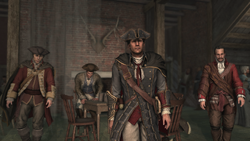
The Colonial Templars at the Wright Tavern
In the years that followed, the Templar Order sought to expand their influence to North America, permitting them to locate and access a hidden First Civilization temple in the region. In 1754, the Grand Master Reginald Birch sent Haytham Kenway, Edward's son, to the British colonies to recruit other Templars there into the quest to find the temple.[24]
After gathering his fellow Templars and assaulting Southgate Fort, Haytham earned the trust of a local Kanien'kehá:ka woman named Kaniehtí:io, who eventually led him to the temple, although he was unable to open it. With his mission a failure, he turned his focus instead to bringing the colonies under the influence of the Templar Order.[24]
The Templars later had the Precursor box, capable of interpreting and translating First Civilization language, in their possession. The Templars hoped to translate the Voynich manuscript, so as to discover the location of any First Civilization temples and obtain the Pieces of Eden. They were unsuccessful in using the box, however.[25]
In 1755, Shay Cormac, a former Assassin, discovered that these temples held Pieces of Eden that did not control power, but rather held the Earth together. If these Pieces were removed or destroyed, they would trigger a massive earthquake. As the Assassins still continued their search for these pieces, Shay joined the Templars so as to stop the Assassins from interfering with these artifacts.[25]
By 1760, Shay had eliminated many of the Assassin's important members, all except for the Mentor Achilles Davenport. Shay convinced Haytham to spare Achilles, reasoning that Achilles finally realised the true purpose of the Pieces of Eden they sought, and that if Haytham killed Achilles, the Assassins would continue their search.[25]
In 1763, the Templars launched an attack on the Assassins in America, decimating the Brotherhood and leaving only Achilles as the sole survivor. However, confident that the old man posed no threat, the Templars allowed him to live quietly on his remote homestead. With the Assassins all but exterminated, the Templars' dominion on the colonies was secured.[24][25]
American Revolution
However, in 1770, a Kanien'kehá:ka boy, Ratonhnhaké:ton - the son of Haytham and Kanienhtí:io - allied himself with Achilles in an effort to save his land and people, and dedicated himself to eliminating the Templars that threatened his village.[24]
After Ratonhnhaké:ton - going by the name of Connor - killed the Templars William Johnson and John Pitcairn, the Templars caught onto the renewed presence of the Assassins; in the meantime, however, the American Revolutionary War was in full swing, and the Templars set about influencing its battles and events to gain the upper hand. Chief among their goals was the ultimate murder or disgrace of George Washington, Commander of the Continental Army, so that he could be replaced with Haytham's right-hand man, Charles Lee.[24]
As the Templars fought on both sides of the conflict, and in various locales, Connor sent his recruits across the colonies to assist the revolutionaries, often eliminating the Templars' presence as they went. By the end of the war, the Templars' network in the newly-formed nation was crumbling.[24]
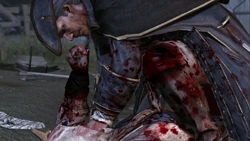
Connor killing Haytham
There was a short time in which Connor and his father Haytham worked together, to find and kill Benjamin Church, a traitor to both the Templar Order and the Continental Army. After killing Church, Connor considered the possibility of the two factions uniting, saying that they could accomplish much more together than either could apart; however, a falling-out between Haytham and his son destroyed any hope of an alliance.[24]

Connor kills Charles
Ultimately, Connor foiled plot after plot, helping the Patriot cause and securing the freedom of his people, and worked to rid the colonies of the last of their Templar influence. After killing his father in New York, Connor focused on the last Templar, Lee, and finally removed the Templars from the United States.[24]
However, in the generations that followed, the Templars once again built their presence in the country and elsewhere around the globe, regaining the advantage in the war against the Assassins.
French Revolution
The French Templar Grand Master, François de la Serre, was murdered in a coup d'etat by former Templar and Sage François-Thomas Germain who sought to use the political turmoil in France to develop a new Templar ideology based on de Molay theories. Instead of continuing to whisper in the ears of the ruling class of aristocrats and monarchs, this new leader and his faction opposed the old guard of the Templars, and thought that by empowering the middle class, and creating a consumerist society, it would be more easy for the Templars to control Humanity. It was unknown if Germain's ideology was also influenced by the memories of his First Civilization incarnation, Aita.[6]
Germain's method of controlling humanity is done by orchestrating the French Revolution, which overthrew the French monarchy and established a Republic in France, led by the Templar and Jacobin Maximilien de Robespierre. Once the Templars were in power, Robespierre would enforce the Reign of Terror to establish tight control over the people in France.[6]
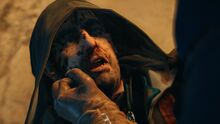
Arno kills Germain
However, this new branch was opposed by both the Assassins and the old guard, the latter led by de la Serre's daughter, Élise. Robespierre was later overthrown and executed by the people for his crimes during his Reign of Terror. On the same day, Germain was assassinated by the Assassin Arno Dorian, though Élise was killed in the resulting conflict as well.[6]
With Robespierre's death, the Templars lost control of the revolution. Both the old and new guard of the Templars collasped as well, as their respective leaders were killed.[6]
Modern times
After the end of the French Revolution and the later Napoleon Bonaparte's fall, the United Kingdom became the first superpower in the world. The new Templar generations, influenced by Germain's theories, understood that the old aristocracy was at an end and the New World Order must be realized through the middle class: the Industrial Revolution was generated by the Templars as means for obtain the power and the control on the masses, together with the research on the Pieces of Eden.[7]
Victorian Era
By the 1860s, under the leadership of Grand Master Crawford Starrick, the British Rite had brought under their control almost all forms of governance within the city of London, which had been under Templar control for the last 100 years. The political, medical, and economic fields, as well as the criminal underworld, were dominated by the Earl of Cardigan, John Elliotson, Philip Twopenny, Maxwell Roth, respectively. Starrick's final goal was the elimination of the British managing class, including the Prime Minister Benjamin Disraeli and Queen Victoria, in order to control the British Empire, and so the world.[7]

The Frye Twins kill Starrick
However, the Templars suffered losses as members of their inner circle were assassinated one-by-one by Jacob and Evie Frye, liberating London from their influence. Finally, with Starrick's death, the Templars lost control of London and were exiled from the city for many years.[7]
War of Currents
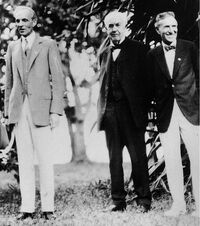
The three leaders of American industry, in Florida
By the 19th century, the Templars had established a major foothold in the American industry, with important figures such as Thomas Edison, Henry Ford and Harvey Firestone being Templars themselves.[3]
During the late 1880s, Edison, who had created a direct current (DC) for electric power distribution, became an adversary of Nikola Tesla, his former employee who had created an alternating current (AC). Jealous of Tesla's more efficient invention, the Templars began to spread propaganda slandering Tesla, like electrocuting an elephant with AC electricity on public television. Additionally, Edison contacted his business associate and fellow Templar J. P. Morgan, who was financing Tesla, informing him of Tesla's intentions to make electricity free to all people and telling him to cut off Tesla's funds. Eventually, the Templars' efforts worked in their favor and DC electricity was distributed across the globe.[3]
During the early 20th century, Ranny Olds and Henry Ford developed and popularized the assembly line, a manufacturing process, to control both capitalists and workers.[12]
Russian Revolution
During the late 19th century, the Templars started gaining strong influence over the Russian Empire and the ruling House of Romanov. Both Tsar Alexander II and Tsar Alexander III became strong allies of the Templar Order, and supported their goals. As a result, the Russian Assassins and its left-wing terrorist offspring the Narodnaya Volya targeted the Romanovs, eventually managing to kill Tsar Alexander II in 1881. The Assassin Nikolai Orelov made an attempt on the life of Tsar Alexander III, in which he was unsuccessful due to the Tsar's surprising strength, stamina and his possession of a Staff of Eden, and the event eventually turned into the Borki train disaster.[26]
Tsar Alexander III died in 1894 of kidney failure. His son Nicholas II, who was not an ally to the Templars, gained control over the Empire, and the Templar agent Grigori Rasputin infiltrated Nicholas' close circle by "miraculously" healing his son. After being close enough, Rasputin replaced the Staff of Eden with a replica,[27] taking the real artifact to a Templar research station in Tunguska.[3]
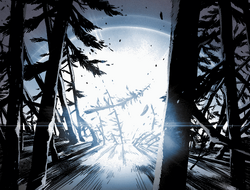
The Tunguska explosion
In 1908, Orelov obtained the station's location and, together with a group of other Assassins, was sent to destroy the artifact. While the Assassins killed the Templars inside and secured the station, their ally Nikola Tesla sent a bolt of electricity from the USA, causing the station to explode and the Staff to be scattered into pieces; known commonly as the Tunguska explosion.[28] Rasputin somehow managed to obtain one of those pieces and used it to hypnotize and control the Imperial family.[27] Rasputin himself was later killed by the Assassins, and the Templars lost control over Russia.[3]
The Russian Imperial family was overthrown during the Russian Revolution, and power shifted to Vladimir Lenin, an ally of the Assassins and leader of the newly formed Soviet Union. Lenin's subordinate, Joseph Stalin, was secretly affiliated with the Templars and took over control of the Soviet Union after Lenin's death.[3]
Founding Abstergo Industries

Abstergo Industries logo
In 1937, the Templars founded Abstergo Industries, a secret company aiming to control capitalists and workers and neutralize communism. The Templars, who had previously created the capitalistic economic system as a façade for their activities, hoped to control the people through owning corporations, as opposed to having people own the companies.[12] The company would go on to control many corporations and organizations around the world, including the Ford Motor Company, NASA, the CIA[3], the US Federal Reserve, Kraft, Coca-Cola, and BP.[12]
World War II
In the late 1930s, Adolf Hitler, an associate of the Templars, began to take over political control over Germany. After having assumed full control, Hitler used an Apple of Eden to form Nazi Germany and hypnotize the population to join his cause. With this new-found support, Hitler began to declare "war" on Germany's neighboring countries, quickly conquering them. A worldwide war - World War II - soon erupted, but the entire war was a Templar plot to keep the people under the Order's control.[3]
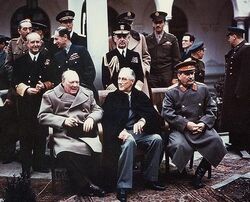
The Big Three at the Yalta Conference
While the entire war was overseen by the Templars, the world was split between two forces. On one side of the war stood the Axis, primarily led by Adolf Hitler, Benito Mussolini and Hideki Tojo. On the other side stood the Allied forces, led by the Franklin D. Roosevelt, Winston Churchill and Joseph Stalin; the Big Three.[3]
On 30 April 1945, Hitler shot his own double inside his Führerbunker to make the people believe he had died, while the real Hitler planned to take the Apple of Eden and meet with Churchill. However, an Assassin had been biding his time outside the Führerbunker, and assassinated Hitler before the latter could make the meeting.[3]
Overthrowing governments
During the 1950s and 1970s, Abstergo Industries heavily involved themselves with opening up the markets to capitalism.[12]
In 1953, the Templars orchestrated the overthrowing of Iranian prime minister Mohammad Mosaddegh, to make the constitutional monarch Mohammad Reza Pahlavi into an authoritarian one. The Shah, SAVAK and Sha'baan Ja'fari terrorized citizens and protected capitalist oil interests, which Mossadegh wanted to go to the people.[12]
Abstergo planned the 1954 coup d’état against Guetemalan president Jacobo Árbenz Guzmán.[12]
JFK assassination and Apollo 11
In the 1960s, the Templars sought to obtain an Apple of Eden that was located on the Moon. However, President John F. Kennedy, who also had an Apple of Eden in his possession, did not share the Templars' motives for space exploration and thus the Templars planned to get rid of Kennedy.[3]
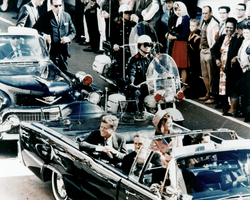
JFK in his car, moments before the assassination
On 22 November 1963, Kennedy was planned to visit Dallas, Texas, in a parade, and the Templars appointed William Greer as his driver, with Lee Harvey Oswald as the primary assassin whilst Abraham Zapruder, who filmed the entire assassination, acted as his support. Oswald shot Kennedy several times, while Greer grabbed the Piece of Eden in the confusion. Moments afterwards, the Templars used another Apple to make a "phantom" appear on the hill near the street, causing more chaos. After Kennedy's death, Vice President Lyndon B. Johnson, who was also a secret Templar, became President of the United States.[3] Greer and Zapruder evaded suspicion, but Oswald was arrested by Dallas police and was shot and killed three days later.
On 20 July 1969, the Templar organization NASA sent the Apollo 11 to the Moon and successfully obtained the Apple of Eden.[3]
Dissolving communism
During the late 20th century, the Templar's support of the Communist system ended, and plans were made to bring about the end of the Communist system.[12]
Abstergo manipulated the American Secretary of State Henry Kissinger into orchestrating the 1973 coup d’état against Chilean president Salvador Allende, who had gained much popularity with the people and wanted the people to own Chile's corporations. Abstergo removed Allende and replaced him with general Augusto Pinochet, who installed a military Junta. Abstergo promised the Chilean capitalists to ensure the Junta remained in power, they would transfer all corporate debt to Argentina.[12]
During the 1990s, Abstergo manipulated Margaret Thatcher, a Prime Minister of the United Kingdom, to contact Boris Yeltsin and inform him that Mikhail Gorbachev, the head of the Soviet Union, did not bear the company's interest at heart. Yeltsin stood up against communism, causing Gorbachev to lose popularity. In December 1991, Yeltsin unseated Gorbachev and became President of the Russian Federation.[12]
Animus Project
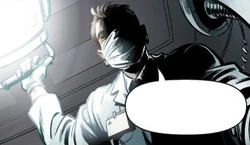
Vidic experimenting on Subject 4
In the late 20th century, Abstergo began abducting people of Assassin descent to use them as subjects for their Animus project. In 1983, they captured a young American boy of Assassin descent who was named Daniel Cross; codename Subject 4.[27] Doctor Warren Vidic used a "working prototype" capable of mimicking a Piece of Eden[12] to plant an impulse into Cross' brain that would make him subconsciously infiltrate the Assassin Order and, when given the opportunity, kill the Order's Mentor.[27] After the operation was successful, Cross was sent into the outside world.[28]
In 2000, the Templars and Assassins both struggled for control over the United States due to the Presidential election.[27] The candidate George W. Bush was used as a puppet by the Templars,[12] while Al Gore was backed by the Assassins.[27] However, before the eventual election took place, Daniel Cross had successfully infiltrated the Assassin Order and killed the Mentor, and Cross returned to Abstergo's Philadelphia facility. The Templars had obtained the locations of all the Assassin camps due to Cross' visits being in his memories, forcing several Assassin cells to relocate and the organisation as a whole to start operating in smaller teams,[27] and the Templars had gained the upper hand in the election.[12]
By September 2012, sixteen test subjects had been "retired" before the company succeeded with the seventeenth – Desmond Miles, a descendant of both Altaïr Ibn-La'Ahad and Ezio Auditore da Firenze.[2][3]
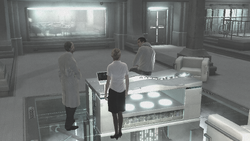
Desmond being held captive in the Abstergo laboratory
For seven days after his capture, Desmond Miles was forced to relive the genetic memories of his ancestor Altaïr in order to reach one specific memory the Templars were seeking. The memory that was valuable to Abstergo registered the moment his ancestor found a holographic map containing the locations of all Pieces of Eden scattered across the world. With the information they had long sought in hand, the Templars set about gathering the remaining Pieces to ensure "absolute peace", although they soon found themselves in a race against the Assassin Order to obtain the Pieces first.[3]
They planned to send a satellite with a Piece mounted on it into orbit, with the launch scheduled on 21 December 2012.[2] Ultimately, Abstergo cancelled the launch of the satellite as they were unable to obtain the required Piece of Eden in time. During this time, two of the Templar leaders, Daniel Cross and Warren Vidic, were assassinated by Desmond Miles, while a third one named Otto Schmidt died under mysterious circumstances.[24]
In spite of these blows, the Templars were able to continue the Animus project, and began selling it to the public as a video gaming console via their multimedia division, Abstergo Entertainment. However, Abstergo's secrets were slowly being divulged to the public by two separate groups, Erudito and the Initiates, the latter becoming allies with the Assassins.[23]

Desmond Kills Warren by using Ezio's Apple
Phoenix Project
Towards the end of 2013, Abstergo Entertainment had the body of the Sage, John Standish, in their possession. The Templars then decided to locate other Sages and study their DNA, so as to find the perfect way to master the use of the Pieces of Eden. They called this research the Phoenix Project.[6]
The Templars also became aware of the existence of a group called the Instruments of the First Will. This group believed that humanity should once again be enslaved to the First Civilization. Abstergo intends to use the Instruments as a way to locate potential Pieces of Eden, though Master Templar Juhani Otso Berg feared that it may be the other way around, that the Instruments may be exploiting Abstergo's resources to further their own gains.[25]
Exploiting Shay Cormac
In 2014, Otso Berg and Sigma Team member Violet da Costa travelled to Abstergo Entertainment to have a research analyst access Shay Cormac's memories. After accessing Shay's memories of his defection to the Templars, Juhani Otso Berg uploaded Shay's memories into the Assassin network, in an attempt to break the Assassins' conviction. Afterwards, the Templars extended an offer of membership to the analyst, otherwise Otso Berg would be forced to kill the analyst.[25]

Shaun Kills Isabelle with his Shock Blade
Locating the Shroud
In 2015, the Templars attempted to locate a Shroud of Eden in London, England. The Assassins were on the same trail after stealing the memories of Jacob and Evie Frye from the cloud server. Sigma Team confronted Assassins Rebecca Crane and Shaun Hastings when the latter confronted Isabelle Ardant, but the Assassins managed to escape.[7]
The Templars later discovered the Shroud beneath Buckingham Palace, but so did the Assassins, who were joined by Galina Voronina. During the resulting skirmish, Hastings snuck up behind Ardant and stabbed her with his shock blade. da Costa managed to escape with the Shroud as the Assassins were forced to retreat. She delivered the Shroud to Álvaro Gramática, who planned on using the Shroud to recreate a living Precursor. Unbeknownst to the Templars, da Costa was secretly a member of the Instruments of the First Will, who was working to restore Juno to physical form.[7]
Quest for Aguilar's Apple
In 2016, Abstergo began a search for another Apple of Eden, one that had formerly been in the possession of the Spanish Assassin Aguilar de Nerha. To this end, the Abstergo Foundation Rehabilitation Center, headed lead by Alan Rikkin's daughter Dr. Sophia Rikkin, staged the execution of criminal Callum Lynch, a descendant of Aquilar, in order to abduct him to process his genetic memories. Prior to this, the Foundation had captured many other descendants of Assassins or similar purposes. These included Moussa, descendant of the Haitian Assassin Adéwalé, Lin, descendant of Chinese Assassin Shao Jun, Nathan, descendant of the Assassin turncoat Duncan Walpole, and Emir, a descendant of the Ottoman Assassin Yusuf Tazim in addition to Callum's father Joseph Lynch.[11]

Callum awakens after his faked death.
Callum was taken to the rehabilitation center in Madrid, where he was forced into an Animus 4.3 to relive the memories of Aguilar. Eventually after several sessions, Abstergo witnessed Aguilar transferring the Apple to the famed Genoese explorer Christopher Columbus. With this information in mind, Sophia and her father promptly fled the facility for Columbus's tomb at the Seville Cathedral, just as their Assassin subjects launched a prison break. In the mean time, as a consequence of the Bleeding Effect, Callum was greeted by ghostly apparitions of his Assassin ancestors, resolving to align with the Assassins.[11]
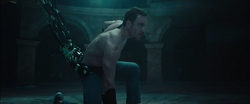
Callum preforming a Leap of Faith
Assassination of Alan Rikkin
Their deduction correct, Alan and Sophia Rikkin successfully looted Aguilar's Apple from Columbus's tomb, an accomplishment Alan felt was paramount for securing the continued support of the Council of Elders for Abstergo Foundation. Not long after, the Council of Elders gathered at a Templar sanctuary in London for a ceremony where Alan was to present the Apple. Unbeknownst to them, the Assassins that had escaped from the rehabilitation center had infiltrated the gathering. Though Sophia met Callum at the hall outside the ceremony, she allowed him to pass through without raising the alarm in a moment of misgivings over the Templars' goals. Thus, just as Alan was activating the Apple before the assembly, he was assassinated from behind by Callum, his throat slit by a Hidden Blade. The rest of the Assassins initiated their assault, and in the ensuing skirmish, the Templars lost the Apple to their sworn enemies.[11]
Ideology and goals
Belief system
- "We're cruel and desperate creatures, set in our conquering ways. The Saxons and the Franks. The Ottomans and Safavids... I could go on for hours. The whole of human history is but a series of conflicts and subjugation. A desire for more, and more, and more."
- ―Haytham Kenway, regarding his view on humanity.[src]
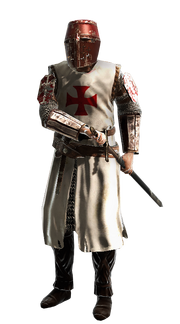
A Templar during the Third Crusade
The existence of the Templars became known to the public in 1129, when its military order was endorsed by the Holy See as a means of countering the ever-increasing threat against the Holy Land by the Saracens, and to protect the city of Jerusalem.[29] Over time, the Templars began to believe it within their power to unite the world in peace.[2]
Their system of belief changed greatly upon the discovery of the Pieces of Eden; they began to speculate that God was a myth and this led the Order to become agnostic, though they publicly maintained the pretense of following the Christian ways so as to not lose the support of the Church.[3] However, select Templars such as David Brewster were deeply religious, believing the powerful artifacts had come from God himself.[7] Even Maximilien de Robespierre tried to establish a deist religion, the Cult of the Supreme Being, based on the Templar Doctrine.[6] During the persecution of the Templars, the last publicly known Templar Grandmaster, Jacques de Molay, cursed King Phillip and Pope Clement V that they will answer for their crimes before God almighty.[6]
Goal
The Templar's true goal is to lead and enlighten humanity so as to transform the world into a self-sustaining progressive utopia, cleansed of the chaotic elements of their natural free will. The Templars view this step as necessary for the world, given he fact that humanity was created to serve and be led by their Gods in the first place.
Obsession with the Pieces of Eden
Realizing the power that the Pieces of Eden held over human beings, the Templars began to seek out the artifacts. In 1191, Robert de Sable, then Grand Master of the Order, personally sought the fabled Apple of Eden, buried in the catacombs of Solomon's Temple, beneath the Temple Mount.[2] The theft of this Piece of Eden by the Order of Assassins renewed the sustained conflict between the two powers, ending with the deaths of De Sable at Arsuf, and Armand Bouchart in Limassol.[15] Despite this setback, the Order continued its mission of creating a world of peace, through manipulation of the Pieces of Eden.
As time progressed, the Templars became more focused on the Pieces of Eden, rather than operating to transform and influence society through non-supernatural means. Their goals changed as they sought to control and unify the entire world using the Pieces of Eden to create a "New World Order".[2][3]
Views on humanity
The Templar Doctrine was based upon an inherently pessimistic view of humanity. As opposed to the Assassins, who believed that free will was an inherent quality and right for all humankind, the Templars insisted that "freedom" caused chaos and upheaval, and ultimately threatens the fabric of civilization itself. Templars hence believe that order, purpose and direction are key in the construction of a perfect world. More moderate Templars would try to influence humanity to have discipline and restraint, as well as opting for tighter and more centralized governmental control. The most fanatical Templars, however, would aim at nothing less than the total destruction of free will, and absolute control over humanity.
Compromising for peace
It is easy to mistake the Templar pursuit for control as a pursuit for power. Whilst many Templars were indeed after power, the Order's base ideology itself is about attaining control in order to enable humanity to transcend beyond their animal roots, and become a species perfectly in harmony and in peace. That is why Templars tend to agree with Assassins when it comes to pursuing peace, but detest their pursuit of freedom. On rare occasions when there is peace between the Assassins and the Templars, such as during François de la Serre's reign as Grand Master, radical elements on both sides may attempt to resume the conflict. Francois de la Serre and his Assassin counterpart, Honoré Mirabeau, both agreed to unite the Two Orders in the sole pursuit of peace using both control and freedom. However, before they could enact this partnership, they were both murdered by their more radical and fanatical subordinates for prioritizing peace over their ideology.
Ethical and unethical practices
Despite the noble ideals of the Order, the Templars were often consequentialists when it came to their methods, which included subterfuge, manipulation of individuals as well as events, murder and even warfare. The Templars' treatment of individuals such as Desmond Miles, Daniel Cross, and Clay Kaczmarek may be perceived as unethical from an isolated standpoint, though the Templars would argue that their many atrocities throughout history have been committed in the name of the greater good. The Templars are liberal in their methods used in the name of the greater good, and is perceived by many to be 'evil' or 'corrupted', or at least bent on domination in many instances.[2] However, while some Templars commit those atrocities fully aware of the magnitude of their actions, others are simply unaware of the atrocities committed in the name of the greater good. Some, such as Maria Thorpe, choose to leave the Templar Order in disagreement with the Order's methods. However, for those that were steeped in the Order's plans and secrets, leaving the Order was nearly an impossible task, as they would usually have been killed to stop them from revealing any information they were party to. The Templars also had no problem with suppressing knowledge, such as when they tried to eliminate Nicolaus Copernicus and murdered Alan Turing, if it suited their purposes, despite their claims that they sought to uplift mankind.
At various points in history, such as during the 18th century, the Templars opposed the unethical treatment and unnecessary killing of innocents, though their definition of an 'innocent' was less broad than that of the Assassin brotherhood.[24] By the early 18th century the Templars had come to view slavery as an unnecessary and questionable practice; Laureano de Torres y Ayala for one believed that "a body enslaved inspires the mind to revolt. But enslave a man's mind and his body will follow on naturally."[23] So strong was the Templars' distaste for the practice that at least one member, Woodes Rogers, was forced out of the Order for continuing to trade in slaves. [30] Many Templars throughout history have shown extremely little issue with harming innocent people for the supposed greater good; Edward Braddock notably slaughtered countless innocent people simply because they either got in the way or because of his belief that random killing would result in people becoming too fearful to disobey. Even children have been shown to not be immune to Templar cruelty; the British Rite extensively used (and promoted) child labour without regard for the dangers such workers faced, the modern purge of the Assassin Order had children mercilessly gunned down in an attempt to eradicate the Assassins and several Inner Sanctum members showed little qualms if children were caught in the crossfire (or in the case of one, dissected for research) of their operations.
Cesare Borgia exemplified the idea of using the Order's might for personal gain
Vulnerability to corruption
The nature of the Order, which involves the acquisition and the exercise of power, makes the Templars highly susceptible to arrogance and corruption. Many have used the Templar cause as a shield or stepping-stone to further their own selfish and cruel desires, attaining power not for the benefit of mankind as was the decree of the order, but for power's own sake. Others like Thomas Hickey or Juan Borgia, likewise, used the Order's considerable connections, wealth and power to attain wealth and luxury of their own.
Dedicated Templar visionaries, who are fully convinced of the Order's righteousness of cause and who lived in service to such an ideal, such as Haytham Kenway and prince Ahmet, are few and far between. The Colonial Rite is most well known for being one of the truly benevolent Templar Rites to have ever existed. Some Templars such as Colonel George Monro saw themselves and their fellow Templars as benevolent protectors and providers of humanity, an act which caused the assassin turncoat Shay Cormac to defect to the Templar Order. The modern-day Templar Juhani Otso Berg took these benevolent Templars as his influential and inspirational examples as to what a Templar should really be.
During the Italian Renaissance, Templar goals were corrupted by Rodrigo and Cesare Borgia into seeking power and domination at all costs, which is far removed from their original noble motive. Modern Templars view the Borgias as debauched tyrants and consider their reign to be a Dark Age of the Order.
Trivia
- Rebecca Crane noted that both the Assassin and Templar Orders had existed since before the formation of the Hashshashin and Order of the Knights Templar respectively, and queried what the two organizations called themselves beforehand.[31]
- In real history, the demonym "Templar" was derived from the order's official name Poor Fellow-Soldiers of Christ and of the Temple of Solomon, with the Temple of Solomon referring to their base, the Al-Aqsa Mosque.
- Historically, after the fall of Acre at 1291, the Templars became bankers rather than actual knights. In fact, it was their banking business that led King Philip IV of France to force Clement V to disband the order and take its wealth for the failing economy of Philip's Kingdom.
References
- ↑ 1.0 1.1 1.2 Assassin's Creed 2: Aquilus
- ↑ 2.00 2.01 2.02 2.03 2.04 2.05 2.06 2.07 2.08 2.09 2.10 2.11 2.12 2.13 Assassin's Creed
- ↑ 3.00 3.01 3.02 3.03 3.04 3.05 3.06 3.07 3.08 3.09 3.10 3.11 3.12 3.13 3.14 3.15 3.16 3.17 3.18 3.19 3.20 3.21 3.22 3.23 3.24 3.25 3.26 3.27 3.28 3.29 3.30 3.31 3.32 3.33 3.34 3.35 3.36 3.37 3.38 3.39 Assassin's Creed II
- ↑ 4.0 4.1 4.2 Assassin's Creed: Lineage
- ↑ 5.00 5.01 5.02 5.03 5.04 5.05 5.06 5.07 5.08 5.09 5.10 5.11 5.12 5.13 5.14 Assassin's Creed: Revelations
- ↑ 6.00 6.01 6.02 6.03 6.04 6.05 6.06 6.07 6.08 6.09 6.10 Assassin's Creed: Unity
- ↑ 7.0 7.1 7.2 7.3 7.4 7.5 7.6 Assassin's Creed: Syndicate
- ↑ 8.00 8.01 8.02 8.03 8.04 8.05 8.06 8.07 8.08 8.09 8.10 Assassin's Creed Encyclopedia
- ↑ 9.0 9.1 9.2 9.3 9.4 9.5 9.6 9.7 Assassin's Creed: The Essential Guide
- ↑ Assassin's Creed: Brotherhood – Multiplayer
- ↑ 11.0 11.1 11.2 11.3 Assassin's Creed: The Movie
- ↑ 12.00 12.01 12.02 12.03 12.04 12.05 12.06 12.07 12.08 12.09 12.10 12.11 12.12 12.13 12.14 12.15 12.16 12.17 12.18 Assassin's Creed: Brotherhood
- ↑ Assassin's Creed 1: Desmond
- ↑ Assassin's Creed: Altaïr's Chronicles
- ↑ 15.0 15.1 15.2 15.3 Assassin's Creed: Bloodlines
- ↑ Assassin's Creed II - Battle of Forlì (DLC)
- ↑ Assassin's Creed II: Discovery
- ↑ Assassin's Creed: Renaissance
- ↑ Assassin's Creed II - Bonfire of the Vanities
- ↑ Assassin's Creed: Project Legacy
- ↑ 21.0 21.1 Assassin's Creed: Brotherhood novel
- ↑ Assassin's Creed: Revelations novel
- ↑ 23.0 23.1 23.2 23.3 23.4 23.5 23.6 Assassin's Creed IV: Black Flag
- ↑ 24.0 24.1 24.2 24.3 24.4 24.5 24.6 24.7 24.8 24.9 Assassin's Creed III
- ↑ 25.0 25.1 25.2 25.3 25.4 25.5 Assassin's Creed: Rogue
- ↑ Assassin's Creed: The Fall - Issue #1
- ↑ 27.0 27.1 27.2 27.3 27.4 27.5 27.6 Assassin's Creed: The Fall - Issue #3
- ↑ 28.0 28.1 Assassin's Creed: The Fall - Issue #2
- ↑ The History Channel, Decoding the Past: The Templar Code, 7 November 2005, video documentary written by Marcy Marzuni
- ↑ Assassin's Creed: Black Flag
- ↑ Assassin's Creed: Syndicate - Database: The Assassin Brotherhood
| ||||||||||||||||||||||||||||
| ||||||||||||||||||||||||||||
| ||||||||||||||||||||||||||||
| |||||||||||||||||||||||||||||||||||||
| ||||||||||||||||||||||||||||
| |||||||||||||||||||||||||||||||||||||
| |||||||||||||||||||||||||||||||||||||
| ||||||||||||||||||||||||||||||||||||||||
| ||||||||||||||||||||||||||||||||||
| ||||||||||||||||||||||||||||||||||||||||
| |||||||||||||||||||||||||||||||
| ||||||||||||||||||||||||||||||||||
| |||||||||||||||||||||||||||||||
| |||||||||||||||||||||||||||||||||||||
| ||||||||||||||||||||||||||||||||||||||||
| |||||||||||||||||||||||||||||||
| ||||||||||||||||||||||||||||||||||
| ||||||||||||||||||||||||||||
| |||||||||||||||||||||||||
| |||||||||||||||||||||||||||||||
| |||||||||||||||||||||||||
| |||||||||||||||||||||||||||||||
| ||||||||||||||||||||||||||||
| |||||||||||||||||||||||||
| |||||||||||||||||||||||||
| |||||||||||||||||||||||||||||||
| ||||||||||||||||||||||||||||
| ||||||||||||||||||||||||||||
| |||||||||||||||||||||||||
| |||||||||||||||||||||||||
| |||||||||||||||||||||||||
| |||||||||||||||||||||||||
| |||||||||||||||||||||||||||||||
| ||||||||||||||||||||||||||||
| ||||||||||||||||||||||||||||
| ||||||||||||||||||||||||||||||||||
| |||||||||||||||||||||||||


